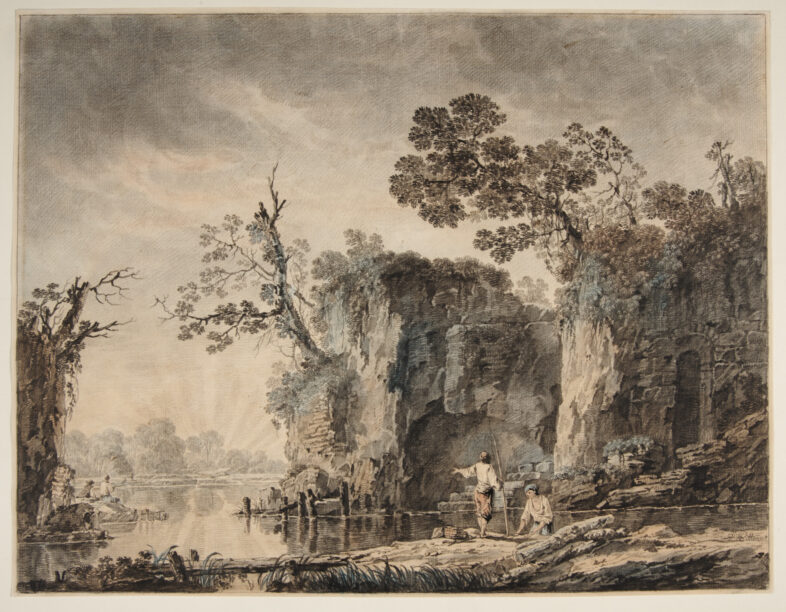
Feb 19, 2025: Williamstown, Massachusetts—The idyllic tranquility of the lives of shepherds became a prominent subject in literature, music, and the visual arts during the seventeenth and eighteenth centuries. A new exhibition at the Clark Art Institute, Pastoral on Paper, explores artistic depictions of rural life by considering their representations of the people and animals who inhabited the landscapes. The exhibition is on view in the Eugene V. Thaw Gallery for Works on Paper in the Clark’s Manton Research Center from March 8 through June 15, 2025.
“The Clark’s works on paper collection is rich with beautiful drawings, etchings, and watercolors depicting these pastoral scenes,” said Olivier Meslay, Hardymon Director of the Clark. “We were delighted when our graduate student intern William Satloff proposed the concept of an exhibition that would give us the opportunity to share so many of these exceptional works of art together. Many of the objects in this presentation have not been on view in quite some time, so it will be a wonderful opportunity for our visitors.”
Satloff, a member of the Class of 2025 in the Williams College/Clark Graduate Program in the History of Art, curated the exhibition under the direction of Anne Leonard, the Clark’s Manton Curator of Prints, Drawings, and Photographs. Satloff has served as a curatorial intern at the Clark since 2023.
“In the Berkshires, we are fortunate to be surrounded by rolling hills, grazing cows, meandering streams, and picturesque barns,” said Satloff. “Moved by these same features, early modern artists created pastoral landscapes. The exquisite works in this exhibition offer an opportunity for us to reflect on our relationship with land both in art and in the world around us.”
ABOUT THE EXHIBITION
Selected primarily from the Clark’s strong holdings of drawings by Claude Lorrain (French, 1604/5–1682) and Thomas Gainsborough (English, 1727–1788) and supplemented with select loans of Dutch Italianate artworks, the exhibition analyzes pastoral imagery to examine how artists construct their own visions of an idealized landscape. This exhibition includes thirty-eight works, including nine drawings, three etchings, and one painting by Claude (Lorrain is typically referred to by his first name) and ten Gainsborough drawings.
Claude perfected the genre of idealized landscape, consolidating the developments of sixteenth-century Italian landscape painters and fusing a sensitive observation of nature with the lofty nobility of classical values. He lived and worked in Rome from the 1620s until his death; there, he influenced the Dutch Italianates—northern European artists who traveled to Italy and embraced the local style of landscape painting.
A century later Thomas Gainsborough developed a new kind of nostalgic, pastoral landscape, inflecting the naturalism of Claude and the Italianates with a yearning for the bygone days of a simpler country life.
ACCESSING ARCADIA
The term “Arcadia” derives from the mountainous Greek province of the same name, and according to myth, it was the domain of Pan, the half-man, half-goat satyr who was revered as the god of pastures and woodlands. In antiquity, Arcadia was known for its population of pastoralists—cowherds, goatherds, shepherds, swineherds—who were celebrated across the ancient world for the skillful singing they did while tending their flocks. The Latin poet Virgil wrote an immensely influential set of ten poems, the Eclogues, about the herdsmen of Arcadia.
During the Renaissance, the intellectual movement known as humanism brought renewed interest in the culture—and particularly the poetry—of ancient Greece and Rome. Although Renaissance humanism waned in the sixteenth century, Virgil’s pastoral poetry continued to inspire artists and writers through the nineteenth century and beyond. Over time, “Arcadia” developed into a general term for an idealized vision of rural life.
Agostino Carracci’s (Italian, 1557–1602) engraving, Omnia vincit Amor (1599), is a visual pun derived from a famous line in Virgil’s tenth Eclogue: “Love conquers all.” Amor is the Latin name for Cupid, the god of desire and erotic love. Pan is both the Greek name of Faunus, the shepherd-god of pastures and woodlands, and the Greek word for “all,” which in Latin is “omnia.” Taken together, Cupid’s victorious combat with the goat-legged god becomes a visual translation of Virgil’s poetry.
In The Cows at the Watering Place (The Cow Drinking) (1680), Nicolaes Berchem (Dutch, 1620–1683) conjures a timeless scene of rural life, full of tranquility and contentment. A shepherd has brought his cows and goats to drink from a stream on a warm, bright day. The animals wade and drink in the water, and a group of people lounge leisurely along the bank. The shepherd, recognizable by his long pole, talks with a seated man who has come to fill his jug, while a woman washes her feet in the stream. An overgrown ruin occupies the midground. At the top of this structure, beneath the vines, is a shadowy relief carving of a knight on horseback slaying a monster—an ambiguous reference to a gallant past.
Christoffel Jegher (Flemish, 1596–1652/53) collaborated with the celebrated Baroque artist Peter Paul Rubens (Flemish, 1577–1640) to produce the monumental woodcut Rest on the Flight into Egypt (after 1632), which corresponds closely to the right side of Rubens’s oil painting Rest on the Flight to Egypt with Saints (1632–1635). Jegher presents the Christ Child sleeping contentedly in the Virgin Mary’s arms at the edge of a dense forest. Two putti, or cherubs, wrestle with a lamb, while a third motions them to be quiet. In the background, Joseph slumbers at the base of a twisting tree while the donkey drinks from a brook.
With its winding river, elegant trees, and grand Romanesque castle, the scene in Landscape with the Voyage of Jacob (1677) is an idealized vision of the countryside near Rome, where Claude spent most of his career. The tiny camels hint at a biblical story, perhaps Jacob’s journey into Canaan, but the other figures scattered across the landscape, such as the herdsman, cows, sheep, dog, and fishermen, give way to another revelation—that the painting is essentially a poetic celebration of the bounty of the natural world.
IDEALIZED LANDSCAPE
Claude and Gainsborough were known to draw landscapes en plein air— meaning that they worked outdoors, directly from the natural environment. Though both artists studied natural features for inspiration, their approach to landscapes varied considerably. Claude’s idealized drawings featured a diffuse light and airy atmosphere aligned with the sensibilities of the Italian countryside. Gainsborough observed nature through a different lens, focusing on the English countryside. Still, each artist endeavored to draw a more pleasing, idealized landscape. Claude often added figures or trees in the foreground to create the illusion of deeper pictorial space. Gainsborough, too, would sometimes make adjustments to the observed landscape—for example, drawing a cluster of trees to one side to balance out the composition.
Claude was fascinated by how ancient and modern Rome melded in the landscape. The early Christian church of Sant’Agnese Fuori le Mura (c. 300s–600s) attracted Claude on more than one occasion. By the seventeenth century, it was surrounded by farms and open pastures. In A View of Sant’ Agnese Fuori le Mura (1650–55), instead of showing the church surrounded by grazing animals, Claude used hills and trees to obscure any sense of historical specificity. While the identifiable architecture indicates the place from where the artist sketched, the building’s late-antique style imparts a temporal mystique evocative of Arcadia.
Claude often went on sketching expeditions around the Roman countryside in the company of fellow artists. On several occasions, he traveled west from Rome along the Tiber River to the town of Tivoli. Nestled in the Sabine Mountains, Tivoli had long been admired for its ancient ruins and scenic vistas. The German painter Joachim von Sandrart (1606–1688) recounted an excursion he and Claude made to Tivoli: “we began to paint entirely from nature […] the mountains, the grottoes, valleys, and deserted places, the terrible cascades of the Tiber, the temple of Sibyl, and the like.” The Cascades of Tivoli (c. 1640), on view in this section of the exhibition, depicts such a scene.
Gainsborough usually sketched the English landscape outdoors directly from nature, such as with Extensive Wooded Landscape with a Bridge over a Gorge, Distant Village and Hills (c. 1786). This practice prompted artist Sir Joshua Reynolds (English, 1723–1792) to remark that Gainsborough, his bitter rival, “did not look at nature with a poet’s eye.” As such he went against the prevalent tendency in eighteenth-century England, where most artists derived their landscapes from Virgil’s Eclogues and Claude’s idyllic Italian scenes. Fashionable collectors displayed paintings and prints of idealized Mediterranean landscapes in their homes, setting the trend of “Italian light on English walls.”
RUINS AND COTTAGES
In pastoral works, architecture is often placed in the midground or background to suggest human habitation of a landscape. In the seventeenth century, pastoral architecture took the form of ruins, indicating that ancient people once held dominion over the land. These ruined buildings—surrounded by overgrown trees and shrubbery—invite viewers to reflect on the greatness of past civilizations, the transience of their glory, and the sublime power of time and nature. In the eighteenth century, pastoral landscapes also came to include cottages, barns, and shacks. By including architectural features within pastoral landscapes, artists may sometimes be making moral, social, and political statements about rural life and land management.
In A Wooded Landscape with a Classical Temple (c. 1645), Claude constructs an imaginary landscape by placing ancient-looking architecture amid dense foliage and rolling hills. Although the bridge visible in the background has been identified as Rome’s famous Milvian Bridge (completed in 109 BCE), there are no clear referents for either the fortress pictured behind the bridge or the classical temple on the left.
Bartholomeus Breenbergh’s (Dutch, 1598–1657) Ruins in a Landscape (c. 1620s) is an early example of Northern European artists’ fascination with ancient architecture. In the shadow of the cavernous ruin, the figures look tiny. Trees grow atop the ruin, juxtaposing the persistence of nature with the ephemerality of Rome’s greatness. Breenbergh moved to Rome in 1619, where he helped found the Roman Society of Dutch and Flemish Painters called the Bentvueghels (active c. 1620–1720). This intellectual and social group, famous for its drunken initiation rituals, included several prominent Italianate landscape painters, such as Jan Asselijn (Dutch, 1610–1652) and Karel Dujardin (Dutch, 1626–1678).
In Dujardin’s The Ruins of a Temple, in the Foreground Two Men and a Dog (1658), two figures overlook a ruin-strewn landscape from a distance, allowing viewers to insert themselves within the pastoral scene rather than observing it as a spectacle. One of the foreground figures sits with a notebook and a writing instrument in his hand, suggestive of the sketching tours that seventeenth-century artists took throughout the countryside around Rome. Though the figure is representative of the common practice of working outdoors, Dujardin actually created this etching in his studio in the Hague.
Pastoral on Paper is organized by the Clark Art Institute and curated by William Satloff, Class of 2025, Williams Graduate Program in the History of Art

